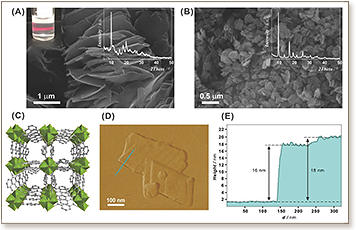

 During the last decade, the synthesis and application of metal–organic framework (MOF) nanosheets has received growing interest, showing unique performances for different technological applications. Despite the potential of this type of nanolamellar materials, the synthetic routes developed so far are restricted to MOFs possessing layered structures, limiting further development in this field. Here, a bottom‐up surfactant‐assisted synthetic approach is presented for the fabrication of nanosheets of various nonlayered MOFs, broadening the scope of MOF nanosheets application. Surfactant‐assisted preorganization of the metallic precursor prior to MOF synthesis enables the manufacture of nonlayered Al‐containing MOF lamellae. These MOF nanosheets are shown to exhibit a superior performance over other crystal morphologies for both chemical sensing and gas separation. As revealed by electron microscopy and diffraction, this superior performance arises from the shorter diffusion pathway in the MOF nanosheets, whose 1D channels are oriented along the shortest particle dimension.
During the last decade, the synthesis and application of metal–organic framework (MOF) nanosheets has received growing interest, showing unique performances for different technological applications. Despite the potential of this type of nanolamellar materials, the synthetic routes developed so far are restricted to MOFs possessing layered structures, limiting further development in this field. Here, a bottom‐up surfactant‐assisted synthetic approach is presented for the fabrication of nanosheets of various nonlayered MOFs, broadening the scope of MOF nanosheets application. Surfactant‐assisted preorganization of the metallic precursor prior to MOF synthesis enables the manufacture of nonlayered Al‐containing MOF lamellae. These MOF nanosheets are shown to exhibit a superior performance over other crystal morphologies for both chemical sensing and gas separation. As revealed by electron microscopy and diffraction, this superior performance arises from the shorter diffusion pathway in the MOF nanosheets, whose 1D channels are oriented along the shortest particle dimension.